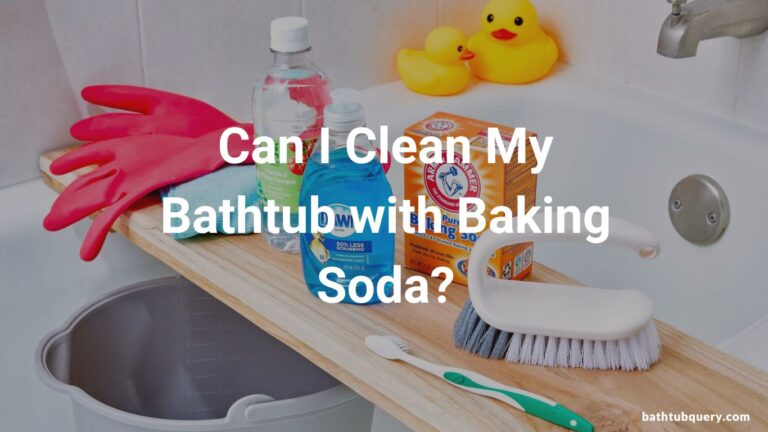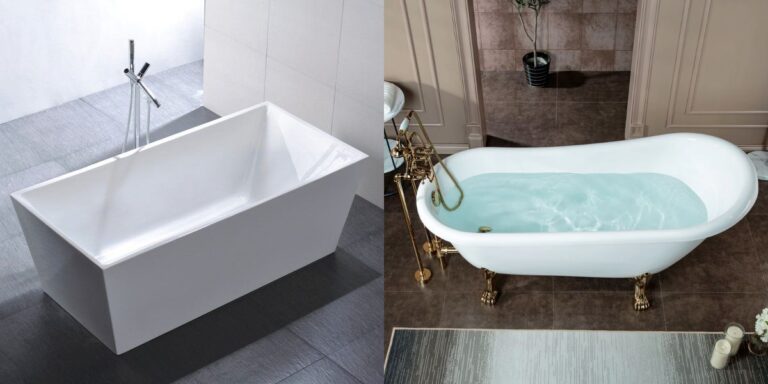4 Types of Bathtub Stains And Removing Solutions
Getting the perfect soak means having a clean and comfortable bathtub. However, regular use, exposure to various substances, and lack of maintenance can lead to different types of bathtub stains, affecting both the look and hygiene of your bathroom. Here, we dive into the world of bathroom blemishes to arm you with knowledge on how to keep your tub pristine.
Types of Bathtub Stains
Hard Water Stains
Hard water stains are one of the most common types of bathtub stains. They are caused by mineral deposits like calcium and magnesium that are found in hard water. Over time, these minerals build up on the surface of your bathtub, leaving behind white, chalky deposits that can be difficult to remove.
Hard water stains start as small spots but can eventually cover large areas of your tub. They make the bathtub look dingy and dirty, even right after cleaning. The porous surface of the bathtub allows the minerals to sink in deeply, making these stains stubborn. Hard scrubbing with bathroom cleaners may lighten them somewhat, but fully removing hard water stains requires special removal products.
Read this if Bathtub Stains Won’t Come Out: The Core Problem And Solution
Soap Scum Stains
Soap scum stains are residue left behind from bathing. When soap combines with the minerals in hard water, it creates a filmy, sticky substance that clings to the bathtub. Soap scum appears as a cloudy, whitish layer that coats the bottom and sides of the tub.
Soap scum stains are most noticeable after showering, when the residue is still wet. As it dries, it hardens into a stubborn buildup. Soap scum accumulates over time, stealing the shine and glossiness from your bathtub. It also makes surfaces feel grimy.
Regular cleaning with an abrasive cleaner can help minimize soap scum. However, removing established stains requires dissolving the sticky film with ingredients like vinegar or ammonia. Scrubbing with a soft cloth or sponge will lift off the dissolved scum.
A related guide on the Brown Stains On The Bottom Of My Bathtub.
Mold and Mildew Stains
Mold and mildew stains occur in bathrooms that are prone to dampness. The warm, wet conditions allow mold spores floating in the air to take hold and multiply. In the bathtub, mold forms dark blotchy stains. The stains may be black, brown, orange, green or even pink or purple.
Mold stains start in tiny spots, but can grow to cover entire surfaces if left untreated. Mildew has a distinctive musty odor and can be slippery. Breathing in mold spores can cause allergic reactions or illness.
Eliminating excess moisture prevents mold growth. Bleach-based cleaners kill and remove existing mildew stains. Reoccurring mold may mean there are moisture problems that need to be addressed.
See this guide How To Clean A Disgusting Bathtub?
Rust Stains
Rust stains in the bathtub have a reddish-brown color and are caused by iron contaminants in the water or corrosion of metal fixtures. Iron in the water supply can leave behind rusty residues. Metal components in the tub, sink and pipes can also corrode and cause rust stains.
Rust appears as splotchy deposits or discoloration. The stains may be small at first but can spread if the cause is ongoing corrosion. Rust can permanently stain and eat away at surfaces over time.
Filtering devices can remove iron from water before it reaches your bathroom. Cleaning rust off quickly and protecting metal fixtures from corrosion will prevent permanent damage. Stubborn rust stains may need special removers or scrubbing with very fine abrasives.
How to Remove Hard Water Stains?
Hard water stains can be stubborn, but fear not. Here’s a simple, step-by-step process to help you regain the shine of your tub:
- Create a paste with equal parts white vinegar and baking soda.
- Apply this paste to the stain and let it sit for 15–30 minutes.
- Scrub gently with a non-abrasive scrubbing pad.
- Rinse and dry your bathtub thoroughly.
Tackling Iron Stains
Iron stains require a slightly different approach. Below is a quick and effective method:
- Prepare a solution by mixing one cup of white vinegar and half a cup of table salt.
- Apply this mixture to the stain and let it sit for up to an hour.
- Scrub away with a soft sponge and rinse well.
Dealing with Mold and Mildew Stains
Mold and mildew can be challenging to eliminate, but with this method, you can effectively remove these stains:
- Spray a mix of one part bleach and two parts water on the affected areas.
- Let it sit for about 20 minutes.
- Scrub away the stains, rinse, and thoroughly dry the tub.
Eliminating Soap Scum
Soap scum can build up quickly and prove to be a nuisance. Here’s how to tackle it:
- Spray a solution of equal parts white vinegar and dish soap on the soap scum.
- Let it sit for 15 minutes before scrubbing.
- Rinse and dry your tub.
Removing Copper Stains
Copper stains can be tough, but with the right method, you can effectively remove them:
- Mix lemon juice and salt to create a paste.
- Apply this mixture to the stain and let it sit for up to an hour.
- Scrub gently, rinse, and dry the tub.
Managing Bathtub Stains Effectively
| Type of Stain | Recommended Cleaning Method |
|---|---|
| Hard Water Stains | Use a vinegar and water solution. |
| Soap Scum Stains | Use a mixture of vinegar and dish soap. |
| Mold and Mildew Stains | Use bleach or a specialized mold and mildew cleaner. |
| Rust Stains | Use lemon juice and salt, or a specialized rust remover. |
Key Takeaways
Understanding the types of bathtub stains can help you choose the right cleaning method and maintain the look and hygiene of your bathroom. Regular cleaning and proper ventilation are key to preventing most types of stains. For stubborn stains, consider seeking professional help.
FAQs
What causes hard water stains?
Hard water stains are caused by high concentrations of minerals like calcium and magnesium in the water.
Why does soap scum form in bathtubs?
Soap scum forms when soap mixes with hard water, leaving a cloudy, white residue on the bathtub.
Can mold and mildew stains pose health risks?
Yes, prolonged exposure to mold and mildew can lead to health issues, especially for people with allergies or respiratory problems.
What leads to rust stains in bathtubs?
Rust stains can occur due to the presence of iron in the water or from metal fixtures in the bathroom.
How often should I clean my bathtub to prevent stains?
For best results, try to clean your bathtub once a week. Regular cleaning can prevent the buildup of stains and keep your tub looking fresh.

William J. Bullock is a licensed plumber with over 15 years of experience installing and repairing bathtubs. He runs his own plumbing company in Greenville and serves residential and commercial clients. William is dedicated to providing honest, transparent advice to help homeowners make informed decisions about their bathroom renovations.
He has established expertise in selecting bathtubs, planning custom installations, diagnosing issues, and completing repairs. William aims to share practical tips and reliable recommendations based on extensive hands-on work. When he isn’t on a job site, William enjoys spending time with his family and volunteering at local community events. He takes pride in delivering quality service and enjoys helping people upgrade their homes.







